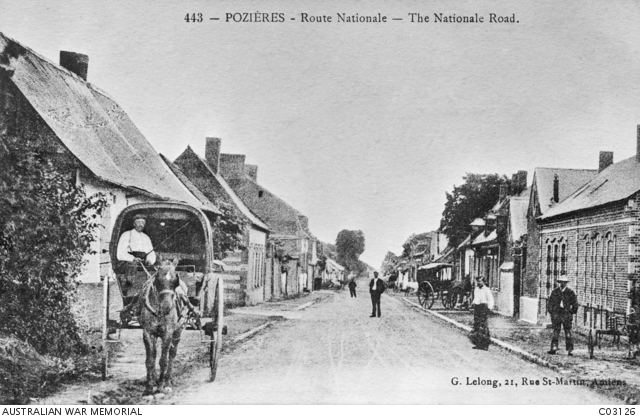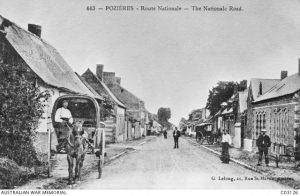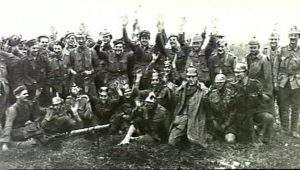The Battle of Pozieres was a phase of the Battle of the Somme on the Western Front in France. It commenced on 23 July 1916 and finished on 3 September 1916 and was the first protracted battle for Australian troops on the Western Front.
By mid July 1916 British attacks on the Somme had brought the front line close to the German occupied village of Pozieres high on the crest of Thiepval Ridge. For the British to advance Pozieres had to be captured. Three Australian divisions of the First Anzac Corps were assigned to the Western Front to help achieve this objective. Less than one third of the Australian reinforcements had fought at Gallipoli; they were largely inexperienced and ill-prepared to deal with the deadly onslaught of the battle-hardened machine that was the German Imperial Army.
It was at Pozieres that Australian soldiers were exposed to the full horrors of the Western Front. They were subjected to incessant German artillery attacks and devastating machine-gun fire, plus intense frontal assaults, all of which took an overwhelming physical and mental toll.
The Australian 1st Division was assigned the task of capturing Pozieres village and moving the Allied line north towards Mouquet Farm. At 12.28am on 23 July, the 1st Division made an assault supported by heavy artillery fire from the British 48th Division. They met with intense fighting and fierce German counter attacks but succeeded in taking the village and capturing the German stronghold of “Gibraltar”, considered by the British to be impregnable.
Sergeant Archie Barwick of the 1st Battalion recorded on 24 July:
All day long the ground rocked and swayed backwards and forwards from the concussion . . . men were driven stark staring mad and more than one of them rushed out of the trench over towards the Germans, any amount of them could be seen crying and sobbing like children their nerves completely gone . . . we were nearly all in a state of silliness and half dazed but still the Australians refused to give ground.
On 27 July, the 1st Division was relieved by the Australian 2nd Division. After just three days of battle the 1st Division had sustained 5,285 casualties. The capture of Pozieres had been a significant achievement, but a very costly one.
The 2nd Division consolidated the Australian position, but also at a cost. When they were relieved by the Australian 4th Division on 6 August they had suffered 6,848 casualties in ten days of fighting. (The 28th Battalion of the 8th Brigade had been reduced to 130 men out of 800; the 27th Battalion had just 100 survivors.)
Alec Raws of the Victorian 23rd Battalion later described the battle:
One feels on a battlefield such as this that one can never survive, or that if the body lives the brain must go forever. For the horrors one sees and the never-ending shock of the shells is more than can be borne. Hell must be a home to it. The Gallipoli veterans here say that the peninsula was a happy picnic to this push … We are lousy, stinking, ragged, unshaven, sleepless … My tunic is rotten with other men’s blood and partly splattered with a comrade’s brains … Several of my friends are raving mad. I met three officers out in No Man’s Land the other night, all rambling and mad. Poor Devils! … The sad part is that one can see no end of this. If we live tonight we have to go through tomorrow night and next week and next month.
The Australian 4th Division was ordered to proceed north along the Pozieres ridge and capture Mouquet Farm. Despite several attempts the 4th Division was not able to achieve their objective. When they were relieved by the Australian 1st Division on 21 August they had sustained 4,649 casualties.
The diminished Australian 1st Division returned to the front line to continue the attack on Mouquet Farm. They made some ground but suffered 2,650 casualties in the process. The Australian 2nd Division returned to replace the remnants of the 1st Division, but did not fair any better, with 1,268 casualties in four days. They were relieved by the Australian 4th Division which continued the attacks on Mouquet Farm on August 27 and 29, but failed to take the position from the German defenders.
The last Australian attack on Pozieres was on 3 September, 1916. Troops of the Australian 1st, 2nd and 4th Divisions had made 19 attacks in 42 days but had sustained a total of 23,000 casualties, including 6,800 dead. Five Victoria Crosses were awarded during the Battle of Pozieres.
On 29 July 1916 official Australian war correspondent CEW (Charles) Bean recorded in his diary:
Pozières has been a terrible sight all day … The men were simply turned in there as into some ghastly giant mincing machine. They have to stay there while shell after huge shell descends with a shriek close beside them … each shrieking tearing crash bringing a promise to each man – instantaneous – I will tear you into ghastly wounds – I will rend your flesh and pulp an arm or a leg – fling you half a gaping quivering man (like those that you see smashed around you one by one) to lie there rotting and blackening like all the things you saw by the awful roadside, or in that sickening dusty crater.
Bean concluded:
Pozieres Ridge is more densely sown with Australian sacrifice than any other place on earth
At least 18 men from the Orange district died in the Battle of Pozieres. They include:
Charles Henry Wilfred Holland
Bertram Henry Frank Collier
Valentine Edward Lohan
Lionel Brizzolara
Mervyn George Hawkins
John Harvey
Herbert Rockliff
Arthur William Snook
James Elliot Bell
William James (‘Bill’) Johnson
Thomas Meynell Curtayne
Eric Brodie McKay
William Thomas Moore
Walter Joseph Stokes
William Isaac Woodbridge
Charles Henry Jude
William George Chrystall
Charles Miller




Hi, I remember watching the ANZAC march down Summer Street in the 70s and there was a WW1 digger who insisted on marching. Towards the end of his days he rode in an open car or maybe a Ford Coupe. Does anyone else remember? Who was the guy?
Neil